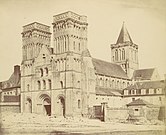Ste-Trinité (Caen)
The monastery church of Sainte-Trinité is one of the two large monastery churches in Caen - next to the church of St-Étienne of the men's abbey. The church of Ste-Trinité and the associated Benedictine abbey was founded around 1060 by Mathilde von Flandern , the wife of Wilhelm I , as a women's convent and consecrated in 1066.
Both churches are considered to be the completion buildings of the Romanesque period in Normandy and, with their ribbed vaults, pioneers of Gothic architecture . They are classified as a monument historique . The six-part cross-ribbed vaults of Ste-Trinité, with their central transverse ribs projecting far downwards, indicate problems of subsequent vaulting. They can be found in a more elegant form in numerous early Gothic churches, including in Germany.
history
The Abbaye aux dame s was donated by Queen Mathilde around 1060 and consecrated in 1066. The women's abbey was created at the same time as the St-Étienne men's abbey founded by Wilhelm I around 1060. The reason for both foundations was Wilhelm's marriage , which was contested by the Holy See . I and Mathildes . Both churches also served as memorial foundations , because in 1083 Mathilde was buried in the church's choir, and in 1087 Wilhelm I was buried in St-Étienne. The monastery foundations in Caen are also at the beginning of the numerous foundations of monasteries in Lower Normandy (Basse Normandie ), which Wilhelm I promoted during his reign in order to network Upper Normandy with the capital in Rouen and Lower Normandy with the capital in Caen. The construction work on Ste-Trinité continued until around 1130. The first abbess Cécile († 1126) was probably her daughter. After the dissolution of the convent in the course of the French Revolution , the monastery building was used for various purposes until the 1980s, including as a hospital. It was the seat of the regional council (Conseil régional) of the Basse-Normandie region until its dissolution in 2016. To mark the occasion, it was completely renovated.
architecture
The architectural specialty of the church are the six-part ribbed vaults, which were built in around 1130 and replaced the flat wooden ceiling. The building material of the monastery, like that of the Abbaye aux Hommes and the castle of Caen, is a local light sandstone, the so-called "stone from Caen" ( Pierre de Caen ). In addition to its good static properties, it can be “carved like wood” and above all creates a warm, light atmosphere in the buildings.
The towers were built in the Middle Ages, but the facade underneath is only a work of the 19th century. The balustrades were added to the towers under Louis XIV .
organ
The organ was built in 1885 by the organ builder Aristide Cavaillé-Coll. The slider chest instrument has 20 stops on two manuals and pedal . The playing and stop actions are mechanical.
|
|
|
|||||||||||||||||||||||||||||||||||||||||||||||||||||||||||||||||||||||||
- Coupling : II / I, I / P, II / P.
literature
- V. Ruprich-Robert: L'architecture normande. Paris 1883.
- L. Musset: Normandy novels. Nuit Temps 1967.
- M. Baylé: La Trinité de Caen. Paris / Geneva 1979.
- Rolf Toman: The Art of the Romanesque. Architecture, sculpture, painting. Könemann, Cologne 1996, pp. 140-143.
- Katrin Brockhaus: L 'abbatiale de la trinité de Fécamp et l'architecture normande au Moyen age. (= Mémoires de la Société des Antiquaires de Normandie. 44). Société des Antiquaires de Normandie, Caen 2009.
Individual evidence
- ↑ Hubert Houben: The Normans . Verlag CH Beck, Munich 2012, ISBN 978-3-406-63727-8 , p. 14 .
- ↑ Patrimloine-Histoire: Caen, abbaye-aux-Dames, église de la Trinité
- ↑ Information on the organ
Web links
- Entry no.PA00111123 in the Base Mérimée of the French Ministry of Culture (French)
- L'Abbaye aux Dames. Neuf siècles d'histoire à Caen (PDF)
Coordinates: 49 ° 11 ′ 11 ″ N , 0 ° 21 ′ 10 ″ W.







